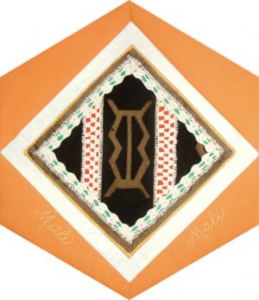Mali

The Block
A traditional example of bogolanfini (mud cloth), donated by H.E. Mamadou Bandiourgou Diawara, forms the base of this block. Making mud cloth is a long-standing part of Mali’s rich textile history. The production of bogolan cloth is a unique and lengthy procedure, which begins with men weaving long strips of cotton cloth and then sewing them together into panels. The fabric is then washed, dried and soaked in a brown solution made from pounded leaves. It is then ready for the mud dye, which has been collected from ponds and left to ferment in a covered pot for about a year. Bogelan dyeing is traditionally a woman’s craft handed down from mother to daughter; however some men, in recent years, have taken it up. Designs––which can take weeks to complete––are outlined using small pieces of bamboo and various widths of metal spatulas. Then wider implements are used to fill in the spaces. The cloth is washed to remove excess mud, leaving a black background, and the process is then repeated.
The inner crocheted frame of the block, which reveals bands of ribbons in national colours, reflects an important skill taught to young girls. Crocheting is a skill that enables them to earn their own money from the sale of their products. A thin band of gold cording frames the piece and symbolizes the importance of gold jewelry to both men and women within their culture.
Cultural Profile
Landlocked Mali, formerly known as French Sudan, is the largest country in West Africa. It is divided into three natural zones: the southern savannah, the central, semi-arid Sahel and the northern, arid Sahara. This desert is rapidly extending south, swallowing whole Malian towns and villages. The nation is home to Timbuktu which was once a major stop on the trans-Saharan route. It is renowned for having three of the world’s oldest mosques. The Djenné Mosque, the largest mud structure on the planet, is a fine example of the Sudano-Sahelian architecture style.
Mali’s diverse population is made up of several ethnic groups including the Bambara, Marka, Songhai, Malinke, Fulani, Tuareg and the Dogon. The Dogon, concentrated along the ‘Cliffs of Bandiagara,’ are known for their pink sandstone villages, which are built along the sides of the escarpment. French is Mali’s official language. While there are numerous African tongues as well, Bambara is spoken by about 80 percent of the population.
Malians, who by nature and by circumstance are stoic and enduring, have a passion for their homeland and their traditional way of life. Most rely on agriculture for their livelihood, even though on-going drought means crops are largely dependent on irrigation or flooding from the Niger River and its tributaries. The country is a big producer of cotton,
Mali has developed a rich cultural heritage despite being one of the world’s poorest countries. Malian music is famed for its richness and diversity. The storytelling of the griots, or djelis, is at the center of the country’s musical traditions. Their art is passed from father to son, and a griot can only marry in another griot’s family. While their songs are used to safeguard the country’s history, the griots are also said to play a role in communication between various, and sometimes conflicting, groups, thus contributing to the maintenance of peace in the country. The kora is the traditional griot instrument. This 21 stringed instrument is made from a dried calabash and cow hide. The ngoni, a lute, drums (which are used for communication as well as music), and the balafon (xylophones) are other important musical instruments. The electric guitar is also widely played. The Tuareg band Tinariwen has gained international recognition with their ‘desert blues’. Malian blues are renowned with artists such as Ali Farka Touré and his son, Vieux Farka Touré. The Festival in the Desert, which takes place outside of Timbuktu, has become a must-go destination for all interested in Mali’s vibrant and hypnotic music scene.
Textile arts in Mali are extensive and varied due to the fact that cotton is so easily available in the country. Dogon people use narrow looms to make strip cloth, using a division of labour based on gender. Women buy the cotton, spin it and pass it on to the men to weave into the needed cloth. The cloth produced is usually white or indigo dyed to produce plain, striped or patterned fabrics. Tie-dye is also widely practiced in the country, especially using indigo dyes. Another technique is the bazin, where heavy cotton damask is imported from Europe, dyed in Mali with either indigo or artificial dyes, then pounded with wooden mallets to make a stiff, shiny and extremely resilient material. Though costly, it is a favourite fabric for both men and women’s clothing. After bazin is used for a while, it loses its special properties, so it is pounded again to restore its former shine and stiffness. Khasa blankets, made by the Fulani people from hand spun wool, is also a notable textile.
Wood carving is a traditional art form used to produce masks, statues and stools. Jewelry and leatherwork are also popular crafts.
People have been coming to Canada from Mali for many years, though in small numbers. The latest census records record less than 2,600 Malians currently living here. Most have settled in Montreal because of the French language
Sponsor: Bela A. and Ilona Rieger
